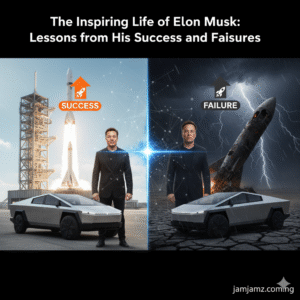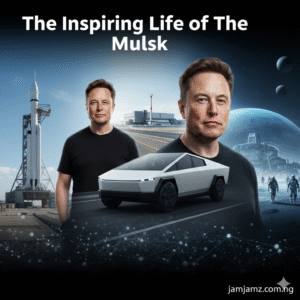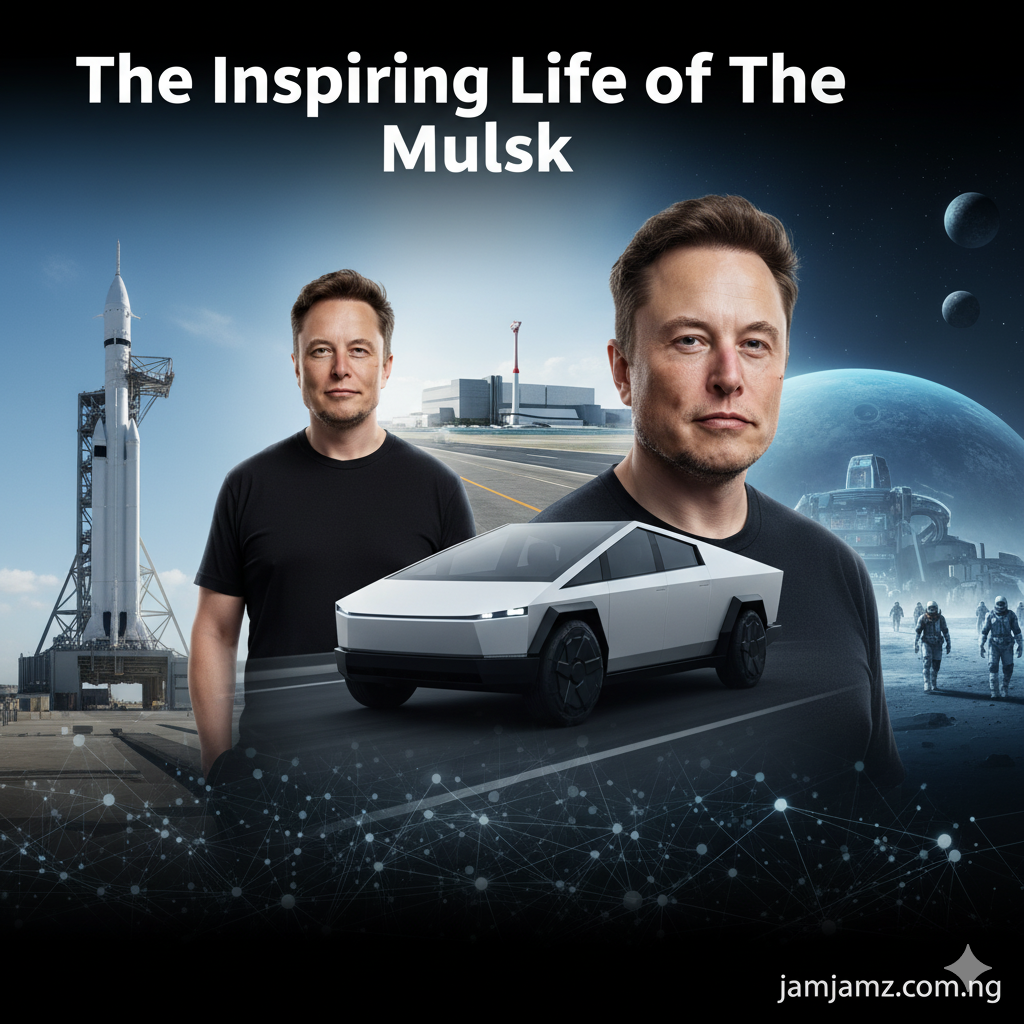The Inspiring Life of Elon Musk: Lessons from His Success and Failures
Elon Musk represents innovation, courage, and ambition. His name connects with groundbreaking ideas that redefine industries and challenge limits. From humble beginnings in South Africa to becoming one of the world’s most influential figures, Musk’s journey shows what determination and vision can accomplish.
His story offers more than business lessons. It’s about resilience, focus, and the mindset that drives transformation. Musk’s life proves that with discipline and belief, anyone can turn a bold dream into a global impact.

Early Curiosity and the Making of a Visionary
Elon Musk was born in Pretoria, South Africa, in 1971. As a child, he showed endless curiosity about science and technology. He loved books more than games and often spent hours reading or working with gadgets.
At age ten, Musk discovered computers. He taught himself how to code and later created a video game called Blastar. When he sold the game at twelve, he experienced the joy of earning from creativity and skill. That early success gave him confidence to build things that solve problems.
Despite facing bullying and personal challenges, Musk never stopped learning. Instead of letting hardship define him, he used it as motivation to grow stronger. His passion for knowledge became the foundation for everything he would later achieve.
ALSO READ: How AI Is Reshaping Business Operations and Decision-Making
ALSO READ: Luxury Real Estate Investments: Best US Cities to Buy
Moving to North America: Chasing Opportunity
Musk believed his goals needed a bigger stage. After finishing high school, he moved to Canada to study at Queen’s University and later transferred to the University of Pennsylvania in the United States.
At UPenn, he earned degrees in physics and economics. Those two subjects shaped his thinking physics taught him logic and problem-solving, while economics gave him the ability to understand markets and scale ideas.
After graduation, he briefly considered pursuing a Ph.D. at Stanford but left after two days. The internet boom had begun, and he wanted to be part of it. That single decision started his entrepreneurial path.
Zip2: The First Breakthrough
In 1995, Musk co-founded his first company, Zip2, with his brother Kimbal. The company provided online business directories and maps to newspapers, something revolutionary at the time. Musk handled programming, strategy, and sales.
He worked long hours, often sleeping in the office to save time. His determination turned Zip2 into a growing business that caught the attention of investors. In 1999, Compaq bought Zip2 for $307 million. Musk received his first major fortune but more importantly, he learned that innovation thrives when backed by effort and timing.
X.com and PayPal: Reinventing Online Payments
After Zip2, Musk wanted to improve online banking. He started X.com, a digital financial service that allowed users to send money through email. Most people distrusted online transactions, but Musk saw the future clearly.
A year later, X.com merged with Confinity, which operated a payment service called PayPal. Together, they created a new model for global online payments. Though Musk later left the company, his leadership helped shape its growth.
When eBay purchased PayPal for $1.5 billion, Musk earned around $180 million. That success confirmed his ability to spot the next big thing before others did.
SpaceX: Bringing Space Within Reach
Instead of enjoying his wealth, Musk set his sights higher literally. He founded SpaceX in 2002 with a bold goal: to make space travel affordable and eventually make life multiplanetary.
At first, few believed in the idea. Musk invested his own money and faced several failed rocket launches. Each failure cost millions and drew criticism. But he refused to stop. He studied what went wrong and fixed it.
In 2008, SpaceX successfully launched Falcon 1 into orbit. It became the first privately funded rocket to reach space. That victory marked the beginning of a new era in space exploration.
NASA later partnered with SpaceX for cargo and crew missions to the International Space Station. Reusable rockets followed, lowering costs and proving that commercial space travel could work. Today, SpaceX stands as one of the world’s most advanced aerospace companies.
Tesla: Driving the Future of Sustainability
While building SpaceX, Musk also joined Tesla Motors in 2004. Electric cars then were slow, expensive, and unpopular. Musk believed they could be fast, stylish, and environmentally friendly.
Tesla’s early years were tough. The company faced production problems, funding shortages, and public doubt. Musk invested his own money to keep Tesla alive.
When the Roadster launched in 2008, it proved that electric cars could perform better than gas-powered vehicles. Later, the Model S, Model X, Model 3, and Model Y made electric cars mainstream.
Under Musk’s leadership, Tesla became the most valuable car company in the world. Its focus on sustainability and innovation inspired other automakers to follow the same path. Tesla’s growth also expanded into solar energy and battery storage, strengthening the global clean energy movement.
The Boring Company and Neuralink: Thinking Beyond Earth
Musk’s creativity didn’t stop with cars or rockets. He founded The Boring Company to solve traffic problems by creating underground tunnels for high-speed transportation.
He also launched Neuralink, a neurotechnology company working to connect the human brain directly to computers. Neuralink’s research aims to treat neurological conditions and enhance cognitive ability.
These ventures reflect Musk’s ability to think beyond limits. He focuses on solving human challenges from traffic to healthcare through technology.
Failures and Lessons Learned
Musk’s story includes failure as much as success. Both SpaceX and Tesla nearly went bankrupt in 2008. He had to borrow money for personal expenses while investing every dollar he had to keep his companies running.
He has faced criticism for his management style, social media statements, and intense work demands. Yet, Musk accepts failure as part of innovation. Each obstacle taught him something new about leadership, focus, and endurance.
His resilience defines his career. He believes that failure doesn’t end progress it refines it.
Leadership Principles from Elon Musk
Elon Musk leads with vision and intensity. He expects high performance from his teams because he demands even more from himself.
1. Dream Boldly and Take Action
Musk turns big ideas into achievable goals. He breaks complex visions into practical steps and executes them without fear.
2. Learn Through Failure
Every setback is a lesson. Musk treats mistakes as information, not defeat.
3. Work Harder Than Anyone Else
He leads by example. His dedication inspires teams to match his energy and commitment.
4. Focus on Value Creation
Musk always asks how technology can help people. Whether it’s clean energy, space travel, or transportation, his work centers on improving life.
5. Never Stop Learning
He reads, studies, and experiments constantly. Musk believes that understanding more allows better decision-making.
How Musk Approaches Innovation
Musk builds innovation from first principles. He breaks problems down to basic truths instead of following assumptions. This method allows him to find unique solutions that others overlook.
For example, instead of accepting rocket prices as fixed, he questioned the reason behind the cost. That thought led to reusable rockets, a breakthrough that changed the aerospace industry.
He also promotes open collaboration within his teams. By sharing ideas freely, Musk encourages creativity and progress.

Philanthropy and Human Progress
Elon Musk uses his influence to support global challenges. Through his foundation, he funds renewable energy projects, scientific education, and environmental sustainability.
He launched initiatives to remove carbon from the atmosphere and improve sustainable living. These actions show his belief that technology must serve humanity.
Musk’s impact goes beyond profit he aims to push civilization forward.
Lessons from Success and Struggle
Musk’s journey teaches that greatness requires risk, persistence, and courage. Every success he achieved came through relentless effort.
Key lessons include:
-
Dream beyond what seems possible.
-
Accept challenges and learn from them.
-
Keep moving forward even when others doubt you.
-
Build solutions that improve lives.
-
Stay hungry for knowledge.
The Legacy of Elon Musk
Musk changed how people travel, communicate, and think about the future. His companies shaped industries that seemed untouchable.
From electric vehicles to reusable rockets, his ideas turned science fiction into reality. Musk’s influence will guide future generations of innovators and entrepreneurs.
His story proves that success isn’t about perfection but about persistence. Musk redefines failure as a part of progress, not the opposite of it.
Conclusion
Elon Musk’s life reminds us that bold dreams demand bold action. He has faced doubt, failure, and criticism, yet his drive never faded. His mindset to learn, adapt, and keep building sets him apart.
Musk teaches that progress comes from vision, focus, and the courage to keep going when others stop. His journey continues to inspire people around the world to challenge limits and create a better future.
